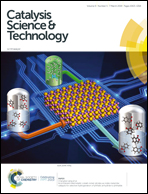Mechanistic insight into the highly regioselective Ni(0)-catalyzed [2 + 2] self-cycloaddition of electron-deficient allenoates†
Abstract
Density functional theory (DFT) calculations have been performed to gain insight into the catalytic mechanism of Ni(0)-catalyzed [2 + 2] self-cycloaddition of electron-deficient allenoates (i.e., 1) to give highly regioselective cyclodimerization products (i.e., 2). The study reveals that the reaction initiated by the Ni(PPh3)2 species, and the whole catalysis can be characterized via three stages: (i) addition of the first equivalent of allenoates 1 to Ni(PPh3)2 gives the thermodynamically stable intermediate IM2-b and PPh3 ligand. (ii) IM2-b reacts with the second equivalent of allenoates 1via low barriers to generate nickelacyclopentane IM4-b. (iii) With the assistance of the third equivalent of allenoates 1, the product 2 is formed via the reductive elimination process, and the nickel-catalyst can be liberated for the next catalytic cycle. The energetic and geometric results of the proposed mechanism, in which only one PPh3 ligand is involved in the actual reaction course, has feasible kinetics and thermodynamics for experimental realization under ambient conditions. In addition, the reasons for the high regioselectivity of the product, as well as the lower efficiency of bidentate ligands are discussed.
![Graphical abstract: Mechanistic insight into the highly regioselective Ni(0)-catalyzed [2 + 2] self-cycloaddition of electron-deficient allenoates](/en/Image/Get?imageInfo.ImageType=GA&imageInfo.ImageIdentifier.ManuscriptID=C8CY02434K&imageInfo.ImageIdentifier.Year=2019)


 Please wait while we load your content...
Please wait while we load your content...